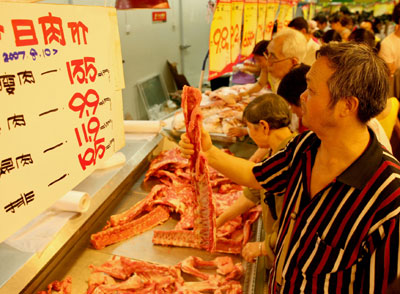Consumer price inflation hits 10-year high
Updated: 2007-08-13 10:28
 Consumers shop for meat at a supermarket in Southwest China's Sichuan Province August 10, 2007. [newsphoto] |
Consumer price inflation in China accelerated to the highest level in more than 10 years as food prices continue to rise, official figures released on Monday showed, raising the possibility for the fourth interest rate hike this year.
The Consumer Price Index (CPI), a barometer of inflation, grew 5.6 percent in July, after a 4.4 percent rise in the previous month and a 3.2 percent increase for the first six months, the National Bureau of Statistics said in a statement on its website. That is well in excess of the official target of three percent.
By contrast, the Producer Product Index (PPI), a measure of inflation at the wholesale level, slowed down to 2.4 percent in July from June's 2.5 percent, the bureau said on Friday.
In a breakdown of July's CPI figures, food prices jumped 15.4 percent, while non-food items rose only 0.9 percent, the statement showed.
Among foodstuffs, meat and meat products reported the biggest increase, up 45.2 percent, followed by a 30.6 percent hike in eggs, and a 30.1 percent rise in cooking oil. Grain prices went up 6.0 percent.
In July, the rural areas saw a 6.3 percent price increase, compared with 5.3 percent for the urban areas, according to the bureau.
Inflation risks were on the rise, the central bank admitted in its second quarter monetary report on Wednesday. It vows to take necessary measures to keep the basic stability in prices.
China has raised interest rates three times so far this year, with the last one on July 20 when the benchmark one-year deposit rate rose to 3.33 percent. That rate hike is coupled with a reduction of interest tax on bank deposits to 5 percent from 20 percent.
However, the return on deposits is still below the inflation rate, indicating a loss of purchasing power if people put their money into banks.
That is encouraging an exodus of bank deposits to the country's red-hot stock market, which has soared 77.53 percent so far this year on top of a 130 percent rally in 2006, fueling concerns of bubbles building in the market.
In response, analysts expect the central bank to raise the interest rates again in the coming months to turn the real interest rate positive, in part to offset the impact of rising prices, and to curb the flow of money into the equity market.
The price hike, especially in foodstuffs, is very sensitive in China as its people have a relatively low disposable income and food accounts for a major part in people’s daily spending. In 2006, the disposal annual income for urban residents stood at 11,759 yuan, and at 3,587 yuan for rural residents.
National Development and Reform Commission (NDRC), the country's top price regulator, has ordered a crackdown on the manipulation of food prices, after several industry associations and firms announced plans to raise prices, including instant noodles and Chinese fast-food chains.
Meanwhile, the Ministry of Civil Affairs raised the urban minimum living allowance for low-income families by 15 yuan a month.
The State Information Center (SIC), a think-tank under the NDRC, agreed on the mounting price hike pressure, but sought to play down concerns over full-scale, significant inflation in a report on Friday, citing stable prices of manufactured products.
Lu Zhongyuan of the Development Research Center of the State Council echoed the SIC's opinion. In the first six months, the core CPI, excluding food and energy, rose a mere 0.9 percent, indicating the inflation is running at a low level, Lu said.
The rationale behind using the core CPI instead of CPI is that food and energy prices are vulnerable to changes in weather and international political situations, and are not a good reflection of substantial change in demand and supply.
However, the central bank suggests close attention be paid to food prices as, unlike in developed countries, food accounts for 34 percent of China's CPI.
The SIC put the CPI growth in the third quarter at 4.3 percent, up from 3.2 percent for the first half of this year, while anticipating the growth to slow down in the fourth quarter as food prices will gradually fall due to greater supplies.
|
|
|
||
|
||
|
|
|
|